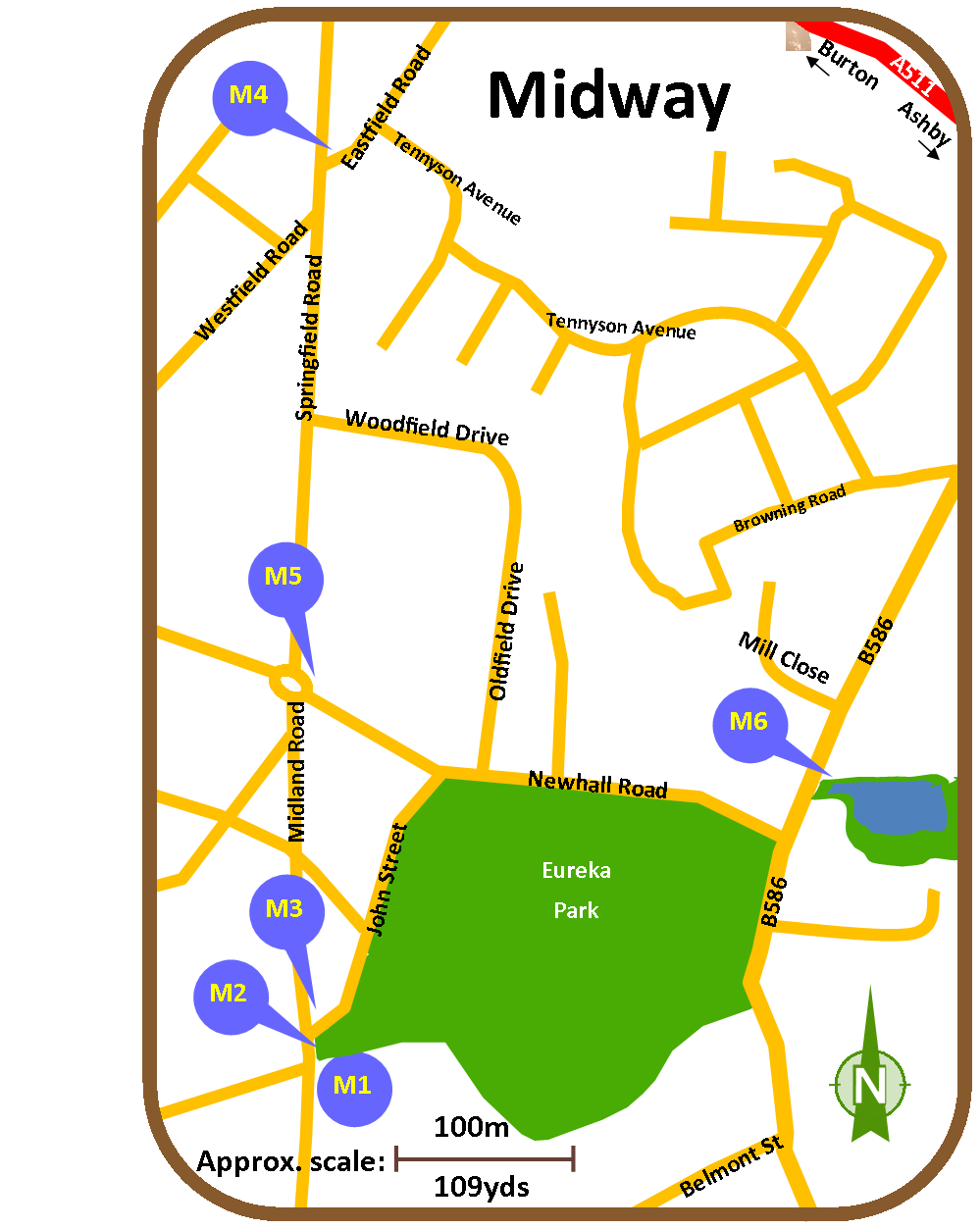Midway Heritage Trail

M1: Tram Sheds
Eureka Park, Midland Road entrance, Midway
In 1906, a tramway system was opened linking the Burton railway station with Ashby and Castle Gresley as well as the villages in between.
The tram sheds were located adjacent to Eureka Park in Midway. This was one of only a few rural tramways.
Eventually, the trams could not compete with the more flexible bus system and the last tram pulled into the Swadlincote sheds on February 19th, 1927.
Following closure of the system, the tram sheds were used to accomodate Thomson’s Fair from 1935 into the 1940s and then for munitions during the Second World War.
Two tram posts can still be seen in Newhall.
Full details can be found in the Swadlincote Heritage Trail 2 (pdf, 2.9mb) leaflet.
M2: Eureka Park
Midland Road, Midway
Eureka Park has a rich history linked to our mining heritage, including the ‘Owd Shoddy’ pit bank near the main park gates.
Many of the local families lost sons in the Great War and Second World War — they are commemorated on the park gates.
There is more about the history of the park in the park itself.
You can also find out more online and in the ‘Footsteps around the Park, Eureka Park’s Past’ walk leaflet, available from Swadlincote Tourist Information Centre, in West Street, Swadlincote.
Full details can be found in the Swadlincote Heritage Trail 2 (pdf, 2.9mb) leaflet.
M3: Owd Shoddy
Midland Road, Swadlincote (next to the entrance to Eureka Park)
In 1880, Moses Cartwright’s colliery was developed. It was known locally as the “Owd Shoddy” pit because of the poor working conditions and badly-faulted coal seams within it.
There were problems with flooding and one of the two shafts collapsed. It closed in the early 1900s.
The face of the grandfather clock that came from the pit and was turned into a complete grandfather clock by Dinnis’ jewellers & watchmakers on High Street.
For more information on the local mining heritage see the ‘Mills, Mines and Murder’ walk leaflet, available from Swadlincote Tourist Information Centre, in West Street, Swadlincote.
Full details can be found in the Swadlincote Heritage Trail 2 (pdf, 2.9mb) leaflet.
M4: Eddie Hardy
Lived near the junction of Eastfield Road/ Springfield Road
Eddie Hardy lived and trained in Midway.
He had a long, distinguished career in athletics. As a member of the Derby and County Athletic Club, he gained international honours for his cross-country running, reaching the European Finals in 1954 and 1955.
He won the Derbyshire Senior mile event seven years in a row.
He retired due to injury in 1956 and joined the administrative side of the sport. He worked until 2000 in various roles including membership of the cross country International Team Selection Committee.
Full details can be found in the Swadlincote Heritage Trail 2 (pdf, 2.9mb) leaflet.
M5: George Widdows
Springfield Junior School Springfield Road
Designed by renowned architect George Widdows whose work maximised natural light and allowed air to circulate— Springfield Junior School saw a new direction for school buildings.
In 1913 ‘The Builder’ magazine stated that his work 'constitutes a revolution in the planning and arrangement of school buildings... a real advance which places English school architecture without a rival in any European country or the United States.'
Widdows’ work on school design still inspires architects today.
Springfield was one of his last: it was completed in 1936 and opened in 1937.
Full details can be found in the Swadlincote Heritage Trail 2 (pdf, 2.9mb) leaflet.
M6: Charlie Hextall
16-18 Midway Road, Swadlincote
Born in 1884, Charlie was one of the more colourful local characters and a regular poacher of game from the nearby Bretby Estate.
During WW1 he served King and country and returned to pursue his local pastime – poaching.
On one occasion he dodged the police by jumping into the pond in Eureka Park, leading them to believe he had drowned. However, he escaped through the culvert at the top of the cascades which became known as the ‘Hole in the Wall’.
Lettering marking this can be seen above the culvert entrance today.
In 1913 he appeared in film ‘A Noble Brother’ as a poacher.
He also turned his hand to coal mining on his land — but after refusing to stop when Moira Coal Company insisted they had the mineral rights, he was forced into bankruptcy.
Full details can be found in the Swadlincote Heritage Trail 2 (pdf, 2.9mb) leaflet.
